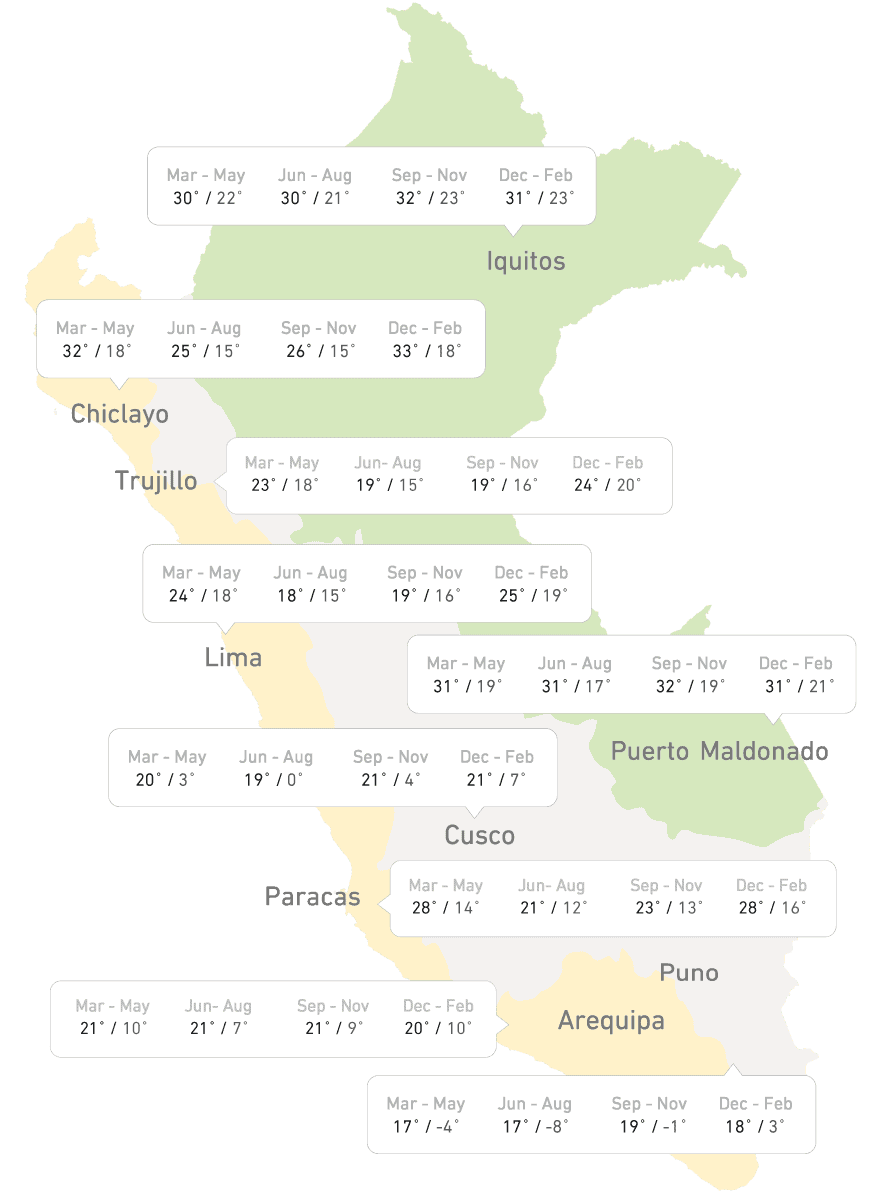
Peru’s climate can be divided into two seasons - wet and dry - though this can vary depending on the region. Temperature is mostly influenced by elevation: the higher you climb, the cooler it becomes.
Peru has 84 of the 104 ecosystems worldwide, but three marked regions:
The coastal region of Peru is cool for its latitude and quite dry year-round. Temperatures are warmest during the summer months (December to March), with hot and humid days of around 29°C (84°F) and cool nights of just below 20°C (68°F). Winters (from April to November) are not too cold but extremely humid.
The highlands have a rainy season (November to April) and a dry season (May to October), when the days are clear and sunny but very cold at night especially at altitude. Dry season is therefore ideal for trekking and for mountaineering. Daytime temperatures will generally be between 16°C- 21°C (60°F and 70°F), although in the intense sunlight of midday it can feel warmer. Night time temperatures can fall as low as -7°C (20°F).
Although the Amazon Jungle is consistently humid and tropical, with significant rainfall year-round, it too experiences two clearly different seasons. During the dry season (May to October), temperatures reach 30°C – 38°C (86°F and 100°F) during the day. From November to April, there are frequent rain showers (which last only a few hours at a time), causing the rivers to swell.
The best time to travel to Peru depends on the specific regions and activities you plan to engage in during your visit.
Dry Season (May to September) is generally considered the best time to visit the most popular destinations of Peru, including Lima, Cusco, Machu Picchu, Lake Titicaca (Puno), Colca Canyon (Arequipa) and the jungle (Iquitos or Puerto Maldonado.
Bear in mind that the Inca Trail (Cusco, Andes) remains closed in February (rainy season).
Most travelers do not require a visa for touristic visits no longer than 90 days, to check if it is required take a look at this list here (if you see a 'Si' under the 'Turista' column then a visa is required)
Peru is served by five major mobile network operators that provide 4G services:
As of now, 5G services are only available in the main cities of the Peruvian Coast for households/local companies with fixed plans. According to the local authority Osiptel Claro offers the fastest mobile speed.
These providers offer prepaid SIM card packages that can be purchased at their official stores, authorized resellers, and even kiosks in major cities. Bring your passport for registration purposes.
However, buying a prepaid SIM card at Lima Airport, particularly at the stand in the arrival hall, is significantly overpriced.
If you are in a rush and have a device that supports e-SIM, you can visit the user-friendly website:
They provide detailed instructions on how to purchase and activate your e-SIM card. Holafly uses Movistar in Peru.
Additionally, Entel also offers e-SIM cards, but this option requires a visit to one of their physical stores.

